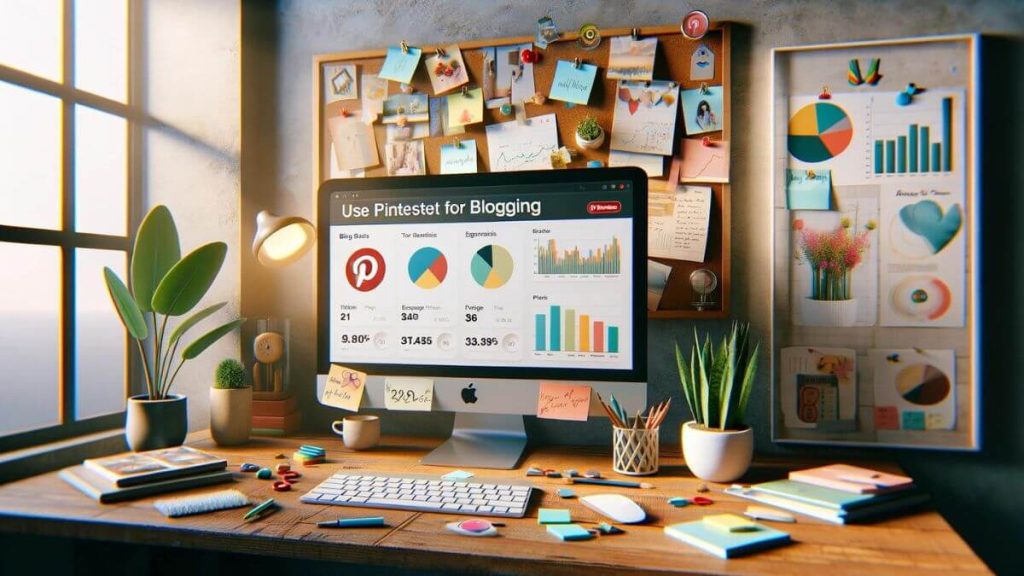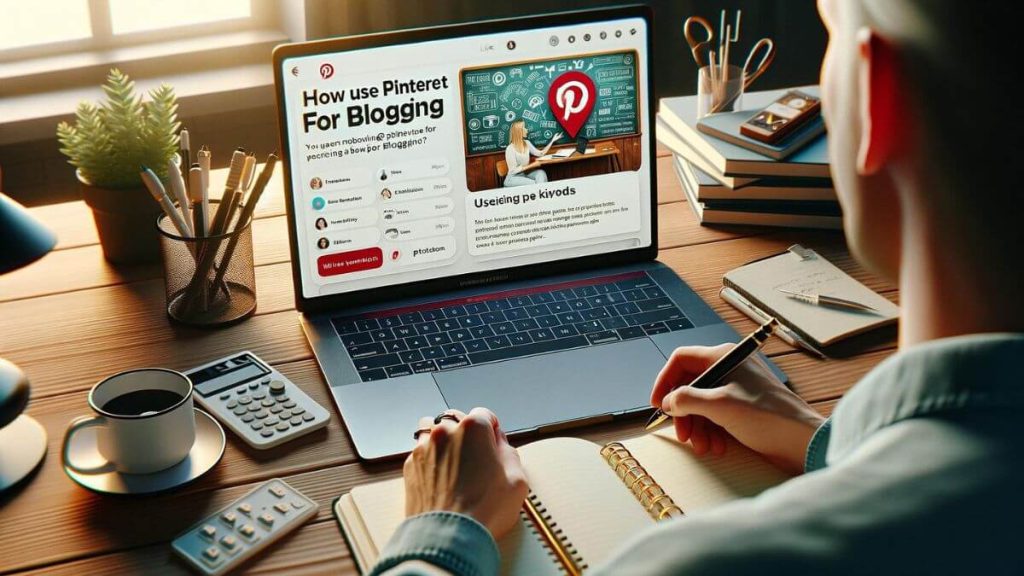How to Use Pinterest for Blogging
In order to learn how to use Pinterest for blogging you have to focus on a few crucial things. I listed a quick answer below, however, the whole article explains in detail the specifics.
To use Pinterest for blogging, create a business account, design eye-catching pins that represent blog content, use relevant keywords in pin descriptions, join group boards to increase visibility, and analyze performance with Pinterest Analytics.
What is Pinterest?
Pinterest is a valuable platform for bloggers looking to increase their website traffic and engage with their audience. With its growing popularity and user base, Pinterest has become the second fastest-growing social network and a top traffic source for many bloggers. By utilizing the right strategies and techniques, bloggers can harness the power of Pinterest to boost their blog’s visibility and attract more readers.
If you are a blogger looking to make the most of Pinterest, you need to learn how to use Pinterest for blogging. There are several key steps you should take.
Firstly, sign up for a Pinterest business account. This will give you access to additional features and analytics that are crucial for effective blog promotion. You can easily create a business account by following the step-by-step instructions provided by Pinterest.
Another important aspect of using Pinterest for blogging is applying for Rich Pins. Rich Pins enhance your blog’s visibility on Pinterest by providing additional information and context to your pins. By optimizing your content with Rich Pins, you can increase your blog’s reach and attract more visitors.
When it comes to promoting your blog on Pinterest, crafting compelling pin descriptions is essential. Your pin descriptions should be engaging and enticing, encouraging users to click through to your blog. Use relevant keywords and be descriptive to attract the right audience to your content.
Timing is key when it comes to pinning on Pinterest. Pinning at the right time can significantly increase your pins’ visibility and engagement. Explore your target audience’s habits and preferences to determine the optimal times to pin your content.
To capture users’ attention on Pinterest, creating pin-worthy images is crucial. Visual appeal plays a significant role in driving engagement on Pinterest. Utilize design tips and tools to create stunning and eye-catching images that will attract users and encourage them to visit your blog.
Engaging with your followers on Pinterest is an essential aspect of building a successful blog. Take the time to interact with your audience, respond to comments, and build relationships. By fostering a sense of community, you can increase your reach and create a loyal following.
Utilizing SEO-friendly keywords on Pinterest is another effective strategy for driving traffic to your blog. Incorporate relevant keywords into your pins and boards to rank higher in Pinterest search results. This will help attract organic traffic, increasing your blog’s visibility and reach.
Your pinning schedule also plays a crucial role in your Pinterest strategy. Consistency is key to maintaining engagement and growing your blog’s presence on Pinterest. Create a pinning schedule that aligns with your target audience’s preferences and habits.
Lastly, optimize your blog for seamless integration with Pinterest. Add Pinterest share buttons to your blog posts, create pinnable images within your content, and consider utilizing Pinterest-related plugins to enhance your blog’s Pinterest integration.
Measuring your Pinterest success is essential to refine and improve your strategy. Utilize Pinterest analytics and other tools to track the performance of your pins. Identify areas for improvement and make data-driven decisions to boost your blog’s performance on Pinterest.
In conclusion, Pinterest offers tremendous potential for bloggers to increase their website traffic and engage with their audience. By following these strategies and techniques, you can leverage the power of Pinterest to drive more readers to your blog and make a lasting impact in the blogosphere.

Why Pinterest is Essential for Bloggers?
Pinterest has emerged as a must-have platform for bloggers, as it has become the number one source of traffic for many successful blogs. With its visually appealing interface and highly engaged user base, Pinterest offers bloggers a unique opportunity to showcase their content and drive traffic to their websites. This is why it is important to know how to use Pinterest for blogging.
One of the key reasons why Pinterest is essential for bloggers is its ability to generate organic traffic. Unlike other social media platforms where content can quickly get lost in the feed, Pinterest pins have a long lifespan, making them highly discoverable over time. This means that even as your blog post ages, it can continue to drive traffic to your website through Pinterest.
Another advantage of using Pinterest for blog promotion is its SEO benefits. Pinterest is essentially a search engine, with users searching for inspiration, ideas, and solutions to their problems. By strategically optimizing your pins and boards with SEO-friendly keywords, you can increase the visibility of your content in Pinterest search results and attract organic traffic to your blog.
- Increased visibility: Pinterest allows you to showcase your blog posts to a wide audience, increasing the chances of attracting new readers.
- Drive traffic: Pinterest can be a significant source of traffic for your blog, helping you reach a larger audience and grow your readership.
- Longevity: Pins on Pinterest have a longer lifespan compared to social media posts, ensuring that your blog posts continue to drive traffic over time.
- SEO benefits: Optimizing your pins and boards with SEO-friendly keywords can improve your visibility in Pinterest search results, attracting organic traffic to your blog.
- Engagement: Pinterest users are highly engaged and actively searching for inspiration and ideas, making it easier to connect with your target audience and build a loyal readership.
By leveraging the power of Pinterest and implementing effective strategies, bloggers can tap into a vast pool of potential readers and drive significant traffic to their websites. Whether you’re just starting out or looking to boost the visibility of your established blog, Pinterest can play a crucial role in your blogging success.
How to Set Up a Pinterest Business Account?
To fully harness the power of Pinterest for your blog, it is essential to set up a Pinterest business account. A business account gives you access to valuable tools and analytics that can help you optimize your pinning strategy and drive more traffic to your website.
To create a business account, start by signing up on the Pinterest for Business website. Fill out the necessary information, including your business name and website. Once you’ve signed up, verify your website by adding a special meta tag or uploading an HTML file provided by Pinterest. This step is crucial as it will enable you to track your website’s performance on Pinterest through analytics.
Once your business account is set up, it’s time to optimize it for success. Start by creating a compelling profile bio that clearly communicates what your blog is about and what value it offers to readers. Use relevant keywords in your bio to make it searchable. Don’t forget to add a link to your blog in the designated space.
Next, organize your boards in a way that makes sense for your blog. Create boards based on different categories or topics related to your content. Be strategic with your board names and descriptions, using SEO-friendly keywords whenever possible. This will ensure that your boards and pins show up in relevant search results on Pinterest.

How to apply for Rich Pins?
Rich Pins are a valuable feature on Pinterest that can significantly improve the visibility and engagement of your blog posts. This is a vital step in learning how to use Pinterest for blogging. By providing additional information directly on the pin, they make your content more informative and appealing to users. To apply for Rich Pins, follow these simple steps:
- Make sure your website is verified with Pinterest. This can be done by adding a meta tag or uploading an HTML file to your website’s backend.
- Go to Pinterest’s Rich Pin Validator tool and enter the URL of a blog post you want to enable Rich Pins for.
- Click on the “Validate” button to check if your HTML is properly formatted for Rich Pins. If any issues are found, make the necessary changes and validate again.
- Once the validation is successful, click on the “Apply now” button to submit your Rich Pin application.
- Wait for Pinterest to review your application. This process usually takes a few days, so be patient.
- Once approved, your blog posts will automatically display as Rich Pins whenever they are saved or shared on Pinterest.
By enabling Rich Pins, you enhance the appearance and functionality of your blog posts on Pinterest, making them more enticing for users to engage with. Take advantage of this feature to showcase your content and attract more traffic to your blog.
Rich Pins provide valuable information directly on the pin, making it easier for users to understand what your blog post is about. This enhanced visibility can lead to higher click-through rates and more traffic to your website. Additionally, Rich Pins help your content stand out in the Pinterest feed, increasing the chances of it being saved and shared by users.
With Rich Pins, you can also include real-time data such as pricing, availability, and product information. This is especially useful for bloggers who write about products, recipes, or DIY projects. By displaying up-to-date information on your pins, you build credibility and trust with your audience.
Overall, Rich Pins are a valuable asset for bloggers who want to optimize their Pinterest strategy. By providing enhanced content and improved user experience, Rich Pins can help you attract more readers and achieve blogging success.
How to Craft Compelling Pin Descriptions?
A well-crafted pin description can make a significant difference in attracting users to click on your pins and visit your blog. It serves as a mini advertisement for your content, enticing users to learn more. To create compelling pin descriptions, consider the following strategies:
- Be descriptive: Clearly explain what your pin is about and why users should be interested. Use relevant keywords that align with your blog post and target audience. Think about what problem your content solves or what value it provides.
- Create curiosity: Spark users’ curiosity by leaving some information out of your pin description. Tease them with a compelling statement that makes them want to click and find out more.
- Include a call-to-action: Encourage users to take action by using action-oriented language in your pin descriptions. Whether it’s “click for more,” “learn how,” or “discover the secrets,” a clear call-to-action can increase engagement.
- Keep it concise: Remember that pin descriptions have a character limit, so keep them short and concise. Aim for around 100-200 characters to ensure your message is clear and impactful.
How to Optimize for Keywords?
In addition to crafting compelling pin descriptions, optimizing them with relevant keywords is essential. By using SEO-friendly keywords in your pin descriptions, you increase the chances of your pins appearing in Pinterest search results. Here are some tips for keyword optimization:
- Research trending keywords: Use keyword research tools or explore Pinterest’s search feature to identify popular keywords in your niche. Incorporate these keywords naturally into your pin descriptions.
- Include long-tail keywords: Long-tail keywords are more specific and targeted. They help you reach a more relevant audience, increasing the likelihood of attracting users who are genuinely interested in your content.
- Experiment and analyze: Continually test different keywords in your pin descriptions and analyze their performance. Monitor which keywords drive the most engagement and use that data to refine your strategy.
By implementing these strategies and optimizing your pin descriptions with relevant keywords, you can increase the visibility of your pins and attract more users to click through to your blog, ultimately driving more traffic and engagement.

Pinning at the Right Time.
Timing plays a crucial role in the success of your Pinterest marketing strategy, as pinning at the right time can significantly impact your blog’s traffic and engagement. To maximize the visibility and reach of your pins, it’s important to understand when your target audience is most active on Pinterest. This is how you use Pinterest for blogging.
One effective strategy is to schedule your pins during peak usage hours. This ensures that your content is more likely to appear in users’ feeds when they are actively browsing and searching for inspiration. Research shows that the best times to pin are during weekday evenings and weekends, as many users tend to explore Pinterest during their leisure time.
How to Optimize Pinning Schedule?
- Identify your target audience’s time zone: Determine the location of your target audience and adjust your pinning schedule accordingly. If you have an international audience, consider using scheduling tools to reach users in different time zones.
- Experiment with pinning frequency: Test different pinning frequencies to find the optimal balance for your audience. Some bloggers find success by pinning several times a day, while others prefer a more strategic approach with fewer but high-quality pins.
- Monitor Pinterest analytics: Utilize Pinterest’s analytics tool to track the performance of your pins and identify peak engagement times. This data will help you refine your pinning schedule for maximum impact.
By strategically timing your pins, you can increase the likelihood of your content being discovered and shared by a larger audience. This can lead to a significant boost in your blog’s traffic and engagement, ultimately helping you achieve your blogging goals.
Eye-catching and visually appealing images are key to capturing users’ attention and driving traffic to your blog through Pinterest. As a blogger, it is crucial to create pin-worthy images that stand out from the crowd and entice users to click through to your blog. Here are some strategies to help you achieve this:
- Use high-quality images: Invest in high-resolution images that are clear, sharp, and visually appealing. Blurry or pixelated images can negatively impact users’ perception of your blog and decrease the chances of them clicking on your pins.
- Add compelling text overlays: Consider adding text overlays to your images to provide context and make them more engaging. Use captivating headlines, quotes, or descriptions that pique users’ curiosity and encourage them to click through to your blog.
- Optimize image dimensions: Pinterest favors vertical images with an aspect ratio of 2:3 or 1:2.5. Design your images with these dimensions in mind to maximize their visibility in the Pinterest feed and increase the chances of them being repinned.
There is more to how to use Pinterest for blogging – don’t forget to include relevant keywords in your image file names and alt tags. This will help improve the searchability of your images on Pinterest and increase the likelihood of them appearing in users’ search results.
By creating pin-worthy images that are visually appealing, informative, and optimized for Pinterest, you can significantly boost your blog’s visibility and attract more traffic from this powerful platform.
Engaging with your Pinterest followers is essential for building a loyal audience and driving traffic to your blog. By interacting and connecting with your followers, you can foster a sense of community and establish yourself as an authority in your niche. Here are some effective strategies to help you engage with your Pinterest followers and grow your blog:
- Respond to comments and messages: Take the time to reply to comments and messages from your followers. This shows that you value their input and appreciate their engagement. Engaging in conversations will also help you establish a connection and build trust with your audience.
- Create interactive content: Encourage your followers to actively participate by creating interactive pins and boards. You can ask questions, run polls, or host contests. This not only increases engagement but also provides valuable insights into your audience’s preferences and interests.
- Feature user-generated content: Showcase content created by your followers to make them feel valued and appreciated. This can be done by creating a dedicated board or highlighting their work in your pins. User-generated content not only fosters a sense of community but also helps to diversify your content and keep it fresh.
- Collaborate with influencers: Collaborating with influencers in your niche can help you reach a wider audience and gain more exposure. Engaging with influencers on Pinterest can be as simple as liking and re-pinning their content or reaching out to them for collaborations. By working together, you can cross-promote each other’s content and attract new followers.
Remember, building a loyal following takes time and consistent effort. Be genuine, and authentic, and provide value to your followers. By implementing these strategies, you can effectively engage with your Pinterest audience and grow your blog.
Engaging with your Pinterest followers is not only about driving traffic to your blog but also about building meaningful connections and establishing yourself as a trusted resource. By actively participating in conversations, creating interactive content, featuring user-generated content, and collaborating with influencers, you can foster a sense of community and grow your blog’s reach on Pinterest. Remember to stay consistent and provide value to your audience. With time and dedication, you can cultivate a loyal following and achieve blogging success with Pinterest.

How to Use SEO-Friendly Keywords on Pinterest?
Incorporating SEO-friendly keywords into your pins and boards is crucial for increasing your blog’s visibility on Pinterest. By optimizing your content with relevant keywords, you can attract more organic traffic and reach a wider audience of potential readers. Here are some strategies to help you effectively use SEO-friendly keywords on Pinterest:
- Research popular keywords: Use keyword research tools to identify popular search terms related to your blog niche. Focus on keywords that have high search volume and low competition.
- Include keywords in your pin descriptions: Write compelling pin descriptions that include relevant keywords. This will help Pinterest understand the content of your pins and rank them higher in search results.
- Create keyword-rich board titles: Optimize your board titles by incorporating relevant keywords. This will make your boards more discoverable and increase their visibility on Pinterest.
- Use hashtags: Include relevant hashtags in your pin descriptions to improve their discoverability. Research popular hashtags related to your content and use them strategically in your pins.
Remember to use keywords naturally and avoid keyword stuffing. Focus on creating high-quality content that provides value to your audience. This will not only improve your visibility on Pinterest but also attract engaged readers to your blog.
How to Create a Consistent Pinning Schedule?
Consistency in pinning is key to maintaining visibility and driving consistent traffic to your blog through Pinterest. By establishing a regular pinning schedule, you can ensure that your content reaches a wider audience and stays relevant in users’ feeds.
Here are some strategies to help you use Pinterest for blogging and create a consistent pinning schedule:
- Set aside dedicated time for pinning: Block off specific time slots in your schedule to focus solely on pinning. This will help you stay organized and ensure that you consistently share quality content.
- Use scheduling tools: Take advantage of scheduling tools like Tailwind or Buffer to plan and automate your pins. These tools allow you to schedule pins in advance, ensuring a steady flow of content without requiring constant manual effort.
- Monitor your analytics: Regularly review your Pinterest analytics to identify peak engagement times for your audience. This data will guide you in determining the most effective times to schedule your pins for maximum visibility and engagement.
- Vary your pinning frequency: Experiment with different pinning frequencies to find the optimal balance for your audience. Some bloggers find success with pinning multiple times a day, while others prefer a more moderate approach. Test different frequencies and monitor the results to refine your pinning strategy.
In addition to creating a consistent pinning schedule, it’s essential to optimize your pins for maximum impact. Here are some tips to help you optimize your pins:
- Create eye-catching images: Use high-quality, visually appealing images that capture users’ attention and make them want to click through to your blog. Incorporate compelling visuals, bold text overlays, and vibrant colors to make your pins stand out.
- Write engaging pin descriptions: Craft compelling and concise pin descriptions that entice users to click through. Include relevant keywords and a clear call to action to drive traffic to your blog.
- Utilize SEO-friendly keywords: Research and incorporate SEO-friendly keywords in your pin descriptions, titles, and board names. This will help your pins rank higher in Pinterest search results and attract organic traffic to your blog.
By following these strategies and optimizing your pins, you can ensure that your blog receives consistent traffic and visibility through Pinterest. Remember to track your analytics and adjust your pinning strategy accordingly to continuously improve your results.
Optimizing Your Blog for Pinterest Integration.
Integrating Pinterest into your blog can enhance the user experience, increase social sharing, and drive traffic to your blog. By following these optimization tips, you can make the most of Pinterest’s potential for content marketing as a blogger.
- Create Pinnable Images: Design visually appealing images that are relevant to your blog content. Use high-quality photos, engaging graphics, and clear text overlays. Make sure the images are vertically oriented since they perform better on Pinterest. Remember to optimize the file names and alt tags with keywords related to your blog post.
- Add Pinterest Share Buttons: Make it easy for your readers to share your blog posts on Pinterest by adding Pinterest share buttons to your website. These buttons encourage social sharing, allowing your readers to save your content to their Pinterest boards and driving more traffic to your blog.
- Enable Rich Pins: Apply for Rich Pins, which automatically pull metadata from your blog posts and display additional information on the pins. This makes your pins more informative and credible, increasing the likelihood of click-throughs to your blog. Rich Pins are available for articles, products, recipes, and more.
With these optimization techniques, you can maximize the visibility and engagement of your blog on Pinterest. Remember to consistently pin fresh content, engage with your followers, and monitor your analytics to track your Pinterest success.

Measuring Pinterest Success with Analytics.
Analytics is a valuable resource for understanding the impact of your Pinterest marketing strategy and optimizing it for maximum results. By diving into the data, you can gain valuable insights into your audience’s behavior, preferences, and engagement with your pins. This knowledge will enable you to make informed decisions and refine your approach to learning how to use Pinterest for blogging and to grow your blog with Pinterest.
One of the key metrics to monitor in Pinterest analytics is the performance of your pins. You can track metrics such as impressions, saves, clicks, and engagement rates for each pin. Analyzing this data will help you identify which pins resonate the most with your audience, allowing you to create more of the content they love.
In addition to pin-level metrics, Pinterest analytics also provide insights into your audience demographics. You can discover the age range, gender, and location of your Pinterest followers. This information is invaluable for tailoring your content and pinning strategy to suit your target audience and reach them effectively.
Another important aspect of analytics is tracking the referral traffic from Pinterest to your blog. By analyzing the traffic data, you can determine which pins or boards are driving the most clicks to your website. This information can guide you in creating more content that appeals to your Pinterest audience and optimizing your blog for Pinterest integration.
Remember that understanding and utilizing Pinterest analytics is an ongoing process. Regularly review your data, test different strategies, and adapt your approach based on what the numbers tell you. By leveraging the power of analytics, you can fine-tune your Pinterest marketing efforts and achieve even greater success in growing your blog.
Conclusion on How to use Pinterest for Blogging
Pinterest can be a game-changer for bloggers, providing a powerful platform to grow their blogs and attract a larger audience. With its impressive growth rate and status as the number one traffic source for many bloggers, it is clear that Pinterest should be an essential part of every blogger’s marketing strategy.
To fully optimize your pinning strategy, it is crucial to sign up for a Pinterest business account. This will unlock valuable features and analytics that are necessary for effective blog promotion. Additionally, applying for Rich Pins is a must. These enhanced pins will make your content more visible on Pinterest and help boost your blog’s SEO.
When crafting pin descriptions, it is important to focus on writing captivating and engaging descriptions that entice users to click through to your blog. Timing is also key on Pinterest, as pinning at the right times can maximize your content’s visibility and engagement. By utilizing scheduling tools, you can ensure that your pins are consistently reaching your target audience.
Visual appeal is crucial on Pinterest, so it’s essential to create pin-worthy images that catch users’ attention. Utilize design tips and tools to enhance the visual appeal of your pins and make them stand out in users’ feeds. Engaging with your followers on Pinterest is another key aspect of successful blog promotion. By building relationships and fostering a sense of community, you can increase your reach and attract more readers to your blog.
Using SEO-friendly keywords is crucial to optimize your content for Pinterest’s search engine. By incorporating relevant keywords in your pin descriptions, boards, and profile, you can increase your visibility and attract organic traffic to your blog. Finally, maintaining a consistent pinning schedule is vital.
By posting regularly and consistently, you can keep your content in front of your audience and drive more traffic to your blog.
In conclusion, mastering how to use Pinterest for blogging successfully requires a combination of strategic techniques and consistent effort. By implementing these Pinterest blogging strategies, you can boost your blog traffic, increase your blog’s visibility, and attract a larger audience to enjoy your valuable content.

Przemo Bania is a blogger and writer whose love of blogging began as an impulse, not as a hobby but a necessity, seeing his wife struggle with endometriosis. Przemo runs two other blogs which you can find by reading his story…

